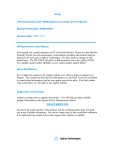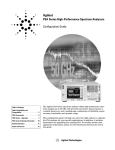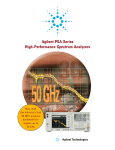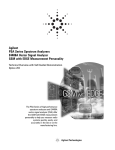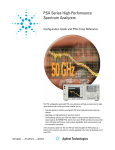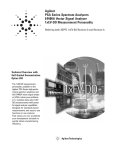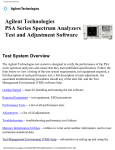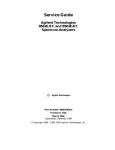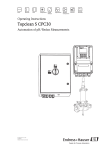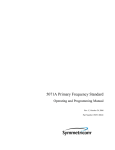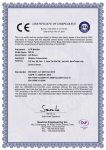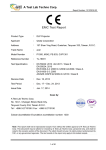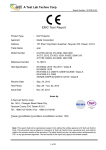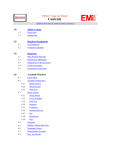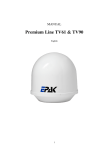Download Installation Note
Transcript
Installation Note Agilent PSA Spectrum Analyzers - Front End Driver Replacement Kit - Option 119 Noise Figure Retrofit Kit for Serial Prefixes US4222 or MY4100 and Earlier Part Number: E4440-90550 Printed in USA December 2002 Notice. The information contained in this document is subject to change without notice. Agilent Technologies makes no warranty of any kind with regard to this material, including but not limited to, the implied warranties of merchantability and fitness for a particular purpose. Agilent Technologies shall not be liable for errors contained herein or for incidental or consequential damages in connection with the furnishing, performance, or use of this material. © Copyright 2002 Agilent Technologies, Inc. Front End Driver Replacement and Option 119 Noise Figure Hardware Retrofit Kits Front End Driver Replacement and Option 119 Noise Figure Hardware Retrofit Kits Product Affected: PSA E4440A, E4443A, E4445A, E4446A, E4448A Serial Numbers: US00000000/US4222and earlier MY00000000/MY4100 and earlier To Be Performed By: (X) Agilent Service Center (X) Personnel Qualified by Agilent ( ) Customer Estimated Installation Time When Using VEE Program 6 hours. 1 hour for hardware installation and 5 hours for performance verification. Estimated Installation Time Without VEE Program 11 hours. 1 hour for hardware installation and 10 hours for adjustments and performance verification. Introduction Agilent introduced the noise figure personality and noise figure hardware on the PSA series spectrum analyzers in December 2002. The noise figure hardware consists of the Front End Driver Assembly, rear dress panel, and the cable included in this kit. This hardware is standard on all PSA analyzers with serial number prefix US4251 or MY4251 and greater. This Front End Driver Replacement kit serves two purposes: The kit is needed to install the latest FE driver into all early instruments listed in this installation note. The hardware contained in the kit allows for future installation of the optional noise figure personality. It is very important all hardware is added even though there may not be plans to add the optional personality. This is because the optional personality is keyed off of the Front End Driver version, and cannot detect the presence of the 28V rear panel cable contained in the kit. Therefore, if only the Front End Driver is installed, the noise figure personality installation firmware could not detect the absence of the rear panel 28V output connection needed to drive the noise source. The second purpose of this kit is to provide the hardware necessary for the Option 219 Noise Figure Personality upgrade. Instruments with serial prefixes listed above will require both this hardware kit, and the Option 219 Noise Figure Personality upgrade kit, before noise figure measurements can be performed. This installation note covers both the E4446A/E4448A version and the E4440A/E4443A/E4445A versions of the retrofit kits. Two kits are needed since the Front End Driver assembly for the E4446A/E4448A is different than the E4440A/E4443A/E4445A. 3 Front End Driver Replacement and Option 119 Noise Figure Hardware Retrofit Kits NOTE NOTE The contents of this retrofit kit require firmware revision Rev A.04.00.or later. NOTE The instrument must be re-adjusted and the performance verified to ensure the instrument meets specifications following the hardware installation. All adjustments are automated, and are included in the PSA Series Performance Tests and Adjustments Software. This software is not included in this kit. If you do not have this software, order option 0BW, PSA Service Documentation and Performance Tests and Adjustments Software, through your local Agilent Technologies Sales and Service Office. 4 Front End Driver Replacement and Option 119 Noise Figure Hardware Retrofit Kits Contents Quantity Description Agilent Part Number 1 Installation Note This note 1 Rear Panel 3 Hole plug, .5 dia 6960-0149 1 Hole plug, .25 dia 6960-0076 1 Cable, coax, 28V Out 8121-0958 1 Nut, 15/32-32 for BNC on 28V cable 2950-0035 1 Front End Driver Assembly E4440-00048 E4440A, E4443A, or E4445A E4440-60242 E4446A or E4448A E4446-60059 1 Front End Driver Utility CD 1 Firmware Upgrade Kit Tools Required ❏ #20 Torx driver ❏ #10 Torx driver ❏ 8mm socket wrench (deep socket, required for SMA connector) ❏ 9/16-inch open end wrench (deep socket, required for BNC connector) ❏ PSA Series Performance Tests and Adjustment Software, A02.00 or later. This software is available as part of E4440AU option 0BW. ❏ Test equipment supported by the software mentioned above. ❏ VEE or a RunTime version of VEE installed on the PC. The RunTime version is available on the Front End Driver Utility CD contained in this kit. 5 Installation Procedure Installation Procedure This installation note contains two installation procedures. One documents the installation using the VEE program. The second does not use the VEE program. VEE program, “FE_Swap.vxe” (Front End driver Swap), copies the calibration files stored on the Front End Driver assembly to a temporary location inside the program. The program will pause and instruct the operator to replace the Front End Driver. Once the replacement assembly is installed, the program transfers the data to the new Front End Driver. This program can save up to five hours of adjustment time depending on the calibration status of the instrument. This program is on the Front End Driver Utility CD contained in this kit. Installation Procedure using the VEE program Overview of Procedure ❏ Determine if the instrument firmware requires updating, and if your PC requires the RunTime version of VEE. ❏ Load the FE_Swap.vxe program. ❏ Run the FE_Swap.vxe program and copy the calibration data from the instrument. ❏ Remove the instrument outer case and top brace. ❏ Replace the Front End Driver assembly. ❏ Restore the calibration data to the replacement Front End Driver. ❏ Install the rear dress panel and 28V cable. ❏ Replace the top brace and instrument outer case. ❏ Perform the performance verification routines. 6 Installation Procedure Determine Which Downloads Are Required And Perform Downloads. 1. Check instrument firmware. Press System, Show System and note the firmware revision. A.04.00 or later is required. 2. If firmware requires upgrading, use the Firmware Update Kit provided in this kit. 3. If firmware reqires updating, assure the instrument is fully functional following the update. 4. If necessary, install the RunTime VEE program. Insert the Front End Driver Utility CD into your PC and follow the on-screen instructions. 5. Install the FE_Swap.vxe program. This program is on the Front End Driver Utility CD also. Insert the CD into your PC and follow the on-screen instructions to load the program. Running the FE_Swap.vxe program. 1. Connect the PC to the instrument via a GPIB cable. 2. Go to the location where you saved FE_Swap.vxe and double click to launch the program. 3. Select Start Program. 4. Follow the on-screen procedure to copy the calibration data from the existing Front End Driver assembly. 5. Power down the instrument, and disconnect the AC power cord and the GPIB cable. 7 Installation Procedure Remove the Outer Case CAUTION If the instrument is placed on its face during any of the following procedures, be sure to use a soft surface or soft cloth to avoid damage to the front panel, keys, or input connector. 1. Disconnect the instrument from ac power. 2. Refer to Figure 1. Remove the two handles on the sides of the instrument as shown. Use the T-20 driver to loosen the screws that attach each handle (1). Remove the handles. 3. Remove the four bottom feet (2). Lift up on the tabs on the feet, and slide the feet in the direction indicated by the arrows. 4. Remove the four screws (3) that hold the rear feet (4) in place. 5. Pull the instrument cover (5) off toward the rear of the instrument. Figure 1 8 Instrument Outer Case Removal Installation Procedure Remove the Top Brace 1. Refer to Figure 2. Use the T-10 driver to remove the top screws (3) (one screw is under the security label), and the side screws (2) attaching the top brace (1) to the deck. 2. Remove the top brace from the deck. Figure 2 Top Brace Removal 9 Installation Procedure Install the Kit Replace the Front End Driver Assembly 1. Locate the A13 Front End Driver assembly. The top brace shows its location, or refer to the service manual. 2. Label the ribbon cable locations so they can be easily reinstalled onto the replacement assembly. 3. Remove the A13 Front End Driver assembly. 4. Install the replacement A13 Front End Driver assembly contained in the kit. Be careful and avoid damaging the cable headers when installing the ribbon cables. Restore the calibration data to the replacement Front End Driver 1. Connect the AC power line and the GPIB cable to the PSA and power up the instrument. 2. It is important to allow the instrument to complete the boot process and auto align routine before pressing the OK button on the PC screen. The auto align may fail some tests or errors may occur. There errors will be cleared when the calibration data is restored. 3. Click the OK button on the PC screen to transfer the data to the replacement assembly. When the transfer is complete, the PC will redisplay the screen that allows you to change the DUT address, exit the program, or start the program over again 4. Power down the instrument. Replace the Rear Dress Panel 1. Remove the nuts from the rear panel BNC and SMA connectors. 2. Label the BNC and SMA connectors so you can easily reinstall the connectors into the correct holes in the replacement rear panel. 3. Remove the 13 screws that secure the dress rear panel to the rear frame. 4. Remove the dress rear panel. 5. Locate the replacement dress panel and the 28v cable included in the kit. 6. Install the BNC end of the 28V cable into the replacement dress rear panel hole marked “Noise Source Drive Out +28V”. Place tape on the 9/16 inch socket to avoid scratching the dress panel. Torque to 236 Ncm (21 in-lbs). 7. Feed the free end of the 28V cable through a rear frame casting hole that lines up with the position of the 28V connector once the dress panel is installed. 8. Attach the SMA connectors to the replacement rear frame. Place tape on the 8 mm socket to avoid scratching the dress panel. 9. Attach all BNC connectors to the dress panel. Assure the “D” in the dress panel aligns with the connector and tighten the nut to hold the connector securely. 10.Attach the dress panel to the rear frame with the 13 screws removed earlier. Torque to 101 Ncm (9 in-lbs). 10 Installation Procedure 11.Torque the BNC connector nuts to 236 Ncm (21 in-lbs) and the SMA connector nuts to 112 Ncm (10 in-lbs). 12.Install the hole plugs, contained in the kit, into the empty BNC and SMA rear panel holes. 13.Connect the 28V rear panel cable to the jack near the rear of the Front End Driver assembly. The jack is J15 for the E4446A and E4448A or J14 for the E4440,E4443 and E4445A. Replace the Top Brace and Outer Case 1. Refer to Figure 2. Carefully position the top brace on the deck. The alignment pin at the center of the web/fan assembly must mate with the alignment hole on the top brace. Make sure that no coaxial cables will get pinched underneath the brace. 2. Use the T-10 driver to replace and tighten the top screws first; then replace the side screws. Torque to 101 Ncm (9 in-lb). 3. Refer to Figure 1. Slide the instrument cover back onto the deck from the rear. The seam on the cover should be on the bottom. Be sure the cover seats into the gasket groove in the front frame. 4. Replace the four rear feet onto the rear of the instrument. Torque to 236 Ncm (21 in-lb). 5. Use the T-20 driver to replace the handles. Torque to 236 Ncm (21 in-lb). 6. Replace the four bottom feet by pressing them into the holes in the case and sliding them in the opposite direction of the arrows until they click into place. Note that the feet at the front have the tilt stands. 11 Installation Procedure Verify the instrument meets specifications The PSA Series Performance Tests and Adjustment Software, A.02.00 and above, must be used to verify the performance of the replacement Front End Driver board you just installed. If a test fails, the adjustment portion of the software may be need to be used to adjust the instrument. The following table lists the minimum performance verification tests needed to verify the replacement Front End Driver is installed correctly. However, to assure the instrument meets specifications, you must perform all verification tests contained in the software. Adjustments The need to adjust the instrument depends on the status of the instrument calibration previous to installing the replacement assembly. Performance Verification 1. Absolute Amplitude Accuracy 2. All Frequency Response tests The results of the performance verification tests will dictate if adjustments are neccessary. Test the rear panel 28V output port by performing the following test: 1. Connect a voltmeter to the rear panel Noise Source Drive Out +28V connector. 2. Press System, More, More, Service. Enter the password −49 and press Enter. 3. Press Service, More, Noise Source ON . The measured value should be 28V dc ±.2 volts. 12 Installation Procedure Installation Procedure Without Using the VEE Program Overview of Procedure ❏ Determine if the instrument firmware requires updating. ❏ Remove the instrument outer case and top brace. ❏ Install the retrofit kit. ❏ Replace the instrument top brace and outer case. ❏ If the instrument is an E4446A or E4448A, initialize the calibration constants for the new hardware. ❏ Perform the adjustments and performance tests. For assistance at any time during this procedure, get in touch with your nearest Agilent Technologies Sales and Service Office. To find your local Agilent office access the following URL or call the following telephone number: http://www.agilent.com/find/assist 1-800-452-4844 (8am-8pm EST) Check Instrument Firmware 1. Press System, Show System and assure the firmware revision is A.04.00 or later. If the firmware requires updating, load the latest firmware using the Firmware Update kit provided in this kit. NOTE It is important that firmware be updated before the new hardware is installed. 2. If firmware was updated, assure the instrument is fully functional following the update. 13 Installation Procedure Remove the Outer Case CAUTION If the instrument is placed on its face during any of the following procedures, be sure to use a soft surface or soft cloth to avoid damage to the front panel, keys, or input connector. 1. Disconnect the instrument from ac power. 2. Refer to Figure 3. Remove the two handles on the sides of the instrument as shown. Use the T-20 driver to loosen the screws that attach each handle (1). Remove the handles. 3. Remove the four bottom feet (2). Lift up on the tabs on the feet, and slide the feet in the direction indicated by the arrows. 4. Remove the four screws (3) that hold the rear feet (4) in place. 5. Pull the instrument cover (5) off toward the rear of the instrument. Figure 3 14 Instrument Outer Case Removal Installation Procedure Remove the Top Brace 1. Refer to Figure 4. Use the T-10 driver to remove the top screws (3) (one screw is under the security label), and the side screws (2) attaching the top brace (1) to the deck. 2. Remove the top brace from the deck. Figure 4 Top Brace Removal 15 Installation Procedure Install the Kit Replace the Front End Driver Assembly 1. Locate the A13 Front End Driver assembly. The top brace shows its location, or refer to the service manual. 2. Label the ribbon cable locations so they can be easily reinstalled onto the replacement assembly. 3. Remove the A13 Front End Driver assembly. 4. Install the replacement A13 Front End Driver assembly contained in the kit. Be careful and avoid damaging the cable headers when installing the ribbon cables. Replace the Rear Dress Panel 1. Remove the nuts from the rear panel BNC and SMA connectors. 2. Label the BNC and SMA connectors so you can easily reinstall the connectors into the correct holes in the replacement rear panel. 3. Remove the 13 screws that secure the dress rear panel to the rear frame. 4. Remove the dress rear panel. 5. Locate the replacement dress panel and the 28v cable included in the kit. 6. Install the BNC end of the 28V cable into the replacement dress rear panel hole marked “Noise Source Drive Out +28V”. Place tape on the 9/16 inch socket to avoid scratching the dress panel. Torque to 236 Ncm (21 in-lbs). 7. Feed the free end of the 28V cable through the hole that lines up with the position of the 28V connector once the dress panel is installed. 8. Attach the SMA connectors to the replacement rear frame. Place tape on the 8 mm socket to avoid scratching the dress panel. 9. Attach all BNC connectors to the dress panel. Assure the “D” in the dress panel aligns with the connector and tighten the nut to hold the connector securely. 10.Attach the dress panel to the rear frame with the 13 screws removed earlier. Torque to 101 Ncm (9 in-lbs). 11.Torque the BNC connector nuts to 236 Ncm (21 in-lbs) and the SMA connector nuts to 112 Ncm (10 in-lbs). 12.Install the hole plugs, contained in the kit, into the empty BNC and SMA rear panel holes. 13.Connect the 28V rear panel cable to the jack near the rear of the Front End Driver assembly. The jack is J15 for the E4446A and E4448A or J14 for the E4440,E4443 and E4445A. 16 Installation Procedure Replace the Top Brace and Outer Case 1. Refer to Figure 4. Carefully position the top brace on the deck. The alignment pin at the center of the web/fan assembly must mate with the alignment hole on the top brace. Make sure that no coaxial cables will get pinched underneath the brace. 2. Use the T-10 driver to replace and tighten the top screws first; then replace the side screws. Torque to 101 Ncm (9 in-lb). 3. Refer to Figure 3. Slide the instrument cover back onto the deck from the rear. The seam on the cover should be on the bottom. Be sure the cover seats into the gasket groove in the front frame. 4. Replace the four rear feet onto the rear of the instrument. Torque to 236 Ncm (21 in-lb). 5. Use the T-20 driver to replace the handles. Torque to 236 Ncm (21 in-lb). 6. Replace the four bottom feet by pressing them into the holes in the case and sliding them in the opposite direction of the arrows until they click into place. Note that the feet at the front have the tilt stands. Test the Front End Driver The PSA Series Performance Tests and Adjustment Software, A.02.00 and above, must be used to adjust and verify the replacement Front End Driver board you just installed. Additionally, if the instrument you are upgrading is an E4446A or E4448A, you must also reset the calibration constants on the Front End Driver before adjustment or verification. E4446A and E4448A ONLY - Calibration Constant Reset Process 1. If the instrument is an E4446A or E4448A, perform the steps below then continue to the Adjust and Verify the Front End Driver section. 2. Launch the “PSA Series Performance Tests and Adjustment Software” on your PC. 3. Configure the unit under test by selecting the appropriate PSA model number and pressing Configure UUT button. 4. Choose the Utilities test plan. 5. Select the Manual Test Selection tab. 6. Run Calibration Constant Reset. 7. Select ONLY “Replacing A13 Front End Driver Assembly” from the list and press OK to reset the calibration constants. 17 Installation Procedure Adjust and Verify the Front End Driver The following table lists the minimum adjustments and verification tests needed to verify the replacement Front End Driver is installed correctly. However, to assure the instrument meets specifications, you must perform all verification tests contained in the software. Adjustments Performance Verification Second LO Power Adjustment Absolute Amplitude Accuracy Lowband Mixer Bias Adjustment Frequency Response FELOMA or SLODA Adjustment YTF Alignment All Frequency Response Adjustments Attenuator Slope Adjustment Overload Detector DAC Adjustment Test the rear panel 28V output port by performing the following test: 1. Connect a voltmeter to the rear panel Noise Source Drive Out +28V connector. 2. Press System, More, More, Service. Enter the password −49 and press Enter. 3. Press Service, More, Noise Source ON . The measured value should be 28V dc ±.2 volts. 18


















